Costing Analysis Report: Traditional vs ABC in Management Accounting
VerifiedAdded on 2019/10/30
|5
|1066
|326
Report
AI Summary
This report evaluates the differences between traditional and Activity-Based Costing (ABC) methods in management accounting, using a case study of Jackson Ltd. The analysis compares overhead allocation and unit prices for two products, Fred and Martha. The traditional method uses direct labor hours to allocate overhead, while ABC identifies various activities and cost drivers. The report calculates unit costs under both methods, revealing that Martha is overpriced and Fred is underpriced under the traditional approach. The ABC method provides a more accurate allocation, leading to a recommended price adjustment for Martha to remain competitive. The report concludes by emphasizing the importance of ABC for informed pricing decisions while acknowledging its potential drawbacks, such as initial costs and complexity. References to key accounting texts are included to support the analysis.
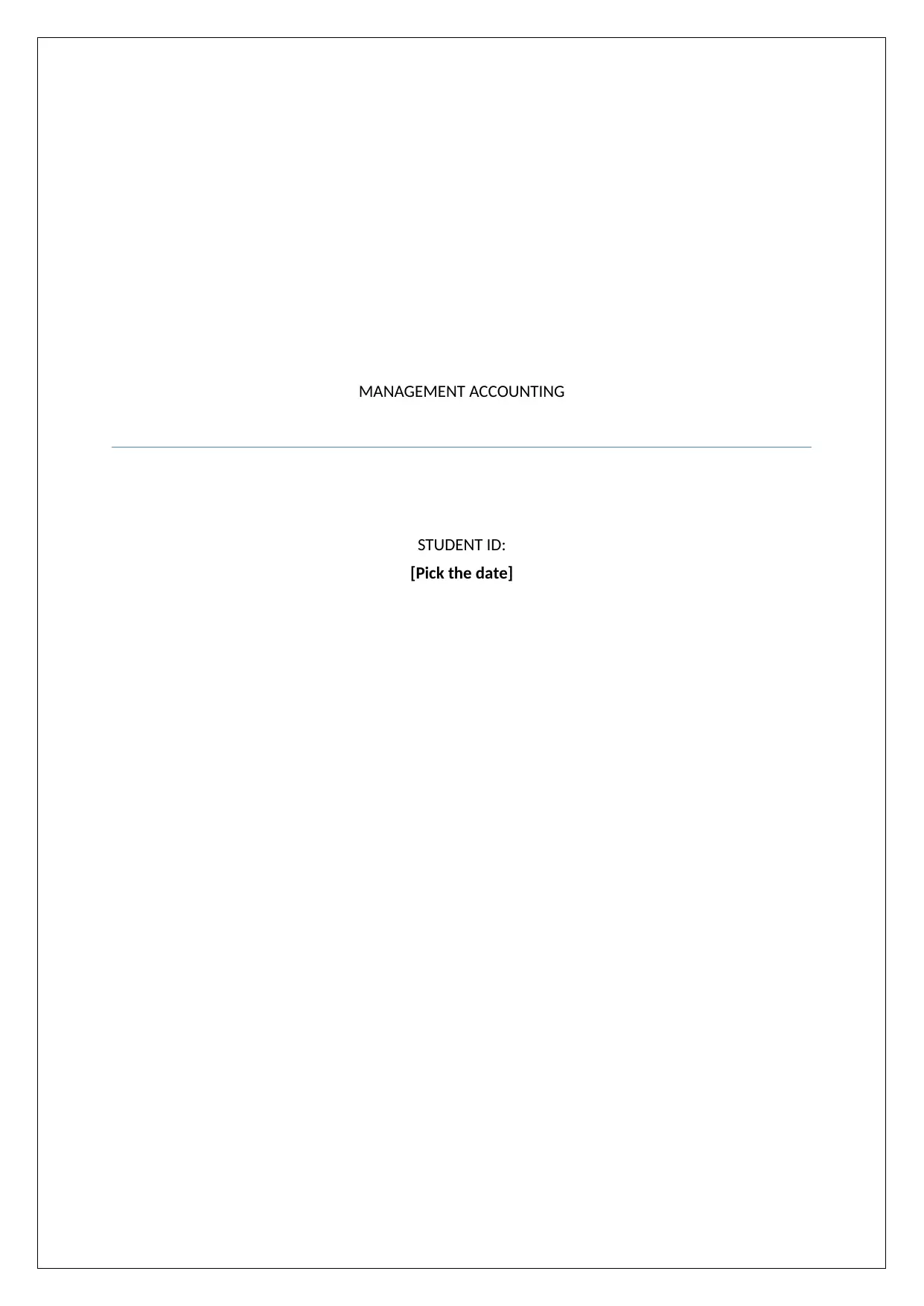
MANAGEMENT ACCOUNTING
STUDENT ID:
[Pick the date]
STUDENT ID:
[Pick the date]
Paraphrase This Document
Need a fresh take? Get an instant paraphrase of this document with our AI Paraphraser
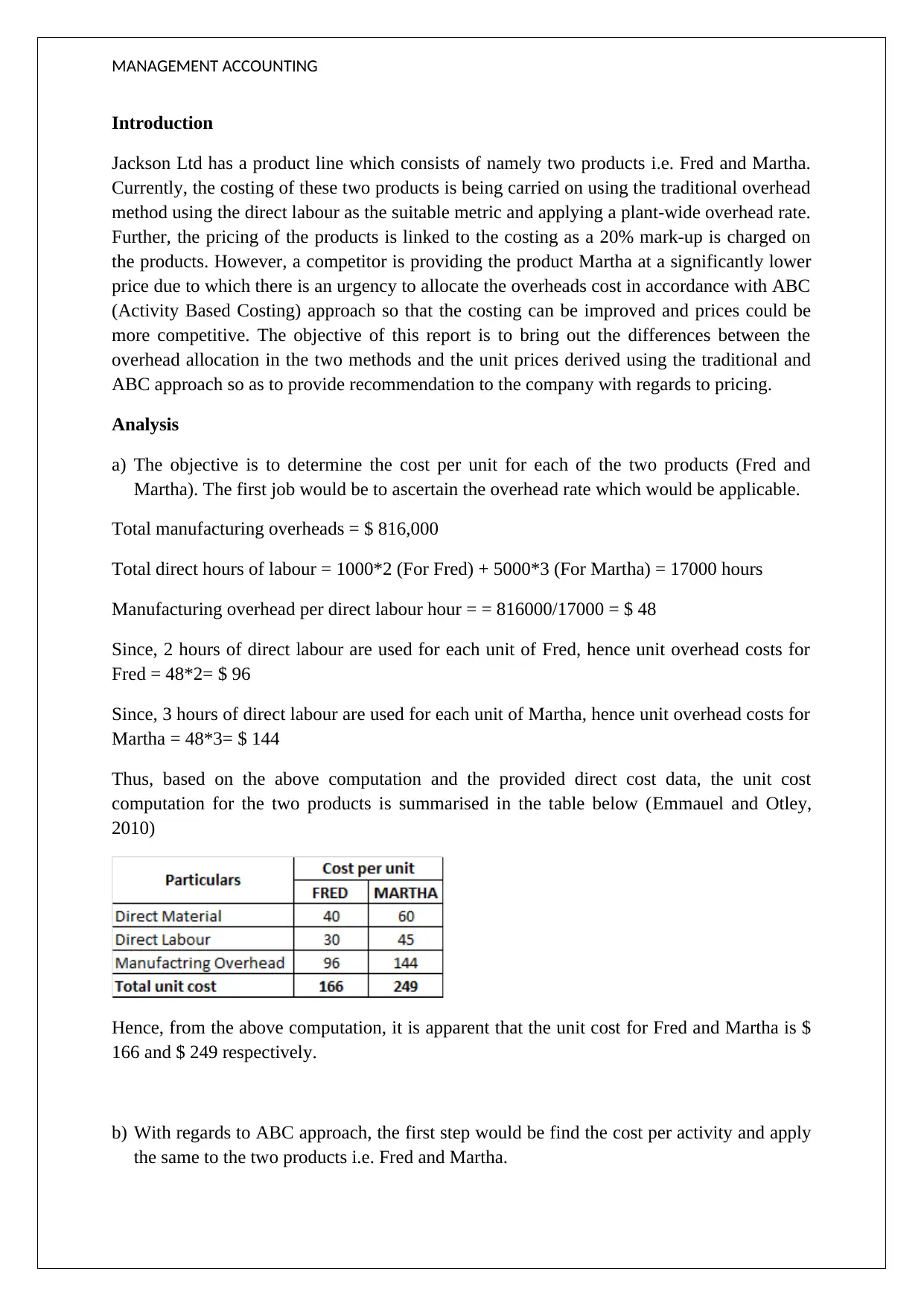
MANAGEMENT ACCOUNTING
Introduction
Jackson Ltd has a product line which consists of namely two products i.e. Fred and Martha.
Currently, the costing of these two products is being carried on using the traditional overhead
method using the direct labour as the suitable metric and applying a plant-wide overhead rate.
Further, the pricing of the products is linked to the costing as a 20% mark-up is charged on
the products. However, a competitor is providing the product Martha at a significantly lower
price due to which there is an urgency to allocate the overheads cost in accordance with ABC
(Activity Based Costing) approach so that the costing can be improved and prices could be
more competitive. The objective of this report is to bring out the differences between the
overhead allocation in the two methods and the unit prices derived using the traditional and
ABC approach so as to provide recommendation to the company with regards to pricing.
Analysis
a) The objective is to determine the cost per unit for each of the two products (Fred and
Martha). The first job would be to ascertain the overhead rate which would be applicable.
Total manufacturing overheads = $ 816,000
Total direct hours of labour = 1000*2 (For Fred) + 5000*3 (For Martha) = 17000 hours
Manufacturing overhead per direct labour hour = = 816000/17000 = $ 48
Since, 2 hours of direct labour are used for each unit of Fred, hence unit overhead costs for
Fred = 48*2= $ 96
Since, 3 hours of direct labour are used for each unit of Martha, hence unit overhead costs for
Martha = 48*3= $ 144
Thus, based on the above computation and the provided direct cost data, the unit cost
computation for the two products is summarised in the table below (Emmauel and Otley,
2010)
Hence, from the above computation, it is apparent that the unit cost for Fred and Martha is $
166 and $ 249 respectively.
b) With regards to ABC approach, the first step would be find the cost per activity and apply
the same to the two products i.e. Fred and Martha.
Introduction
Jackson Ltd has a product line which consists of namely two products i.e. Fred and Martha.
Currently, the costing of these two products is being carried on using the traditional overhead
method using the direct labour as the suitable metric and applying a plant-wide overhead rate.
Further, the pricing of the products is linked to the costing as a 20% mark-up is charged on
the products. However, a competitor is providing the product Martha at a significantly lower
price due to which there is an urgency to allocate the overheads cost in accordance with ABC
(Activity Based Costing) approach so that the costing can be improved and prices could be
more competitive. The objective of this report is to bring out the differences between the
overhead allocation in the two methods and the unit prices derived using the traditional and
ABC approach so as to provide recommendation to the company with regards to pricing.
Analysis
a) The objective is to determine the cost per unit for each of the two products (Fred and
Martha). The first job would be to ascertain the overhead rate which would be applicable.
Total manufacturing overheads = $ 816,000
Total direct hours of labour = 1000*2 (For Fred) + 5000*3 (For Martha) = 17000 hours
Manufacturing overhead per direct labour hour = = 816000/17000 = $ 48
Since, 2 hours of direct labour are used for each unit of Fred, hence unit overhead costs for
Fred = 48*2= $ 96
Since, 3 hours of direct labour are used for each unit of Martha, hence unit overhead costs for
Martha = 48*3= $ 144
Thus, based on the above computation and the provided direct cost data, the unit cost
computation for the two products is summarised in the table below (Emmauel and Otley,
2010)
Hence, from the above computation, it is apparent that the unit cost for Fred and Martha is $
166 and $ 249 respectively.
b) With regards to ABC approach, the first step would be find the cost per activity and apply
the same to the two products i.e. Fred and Martha.
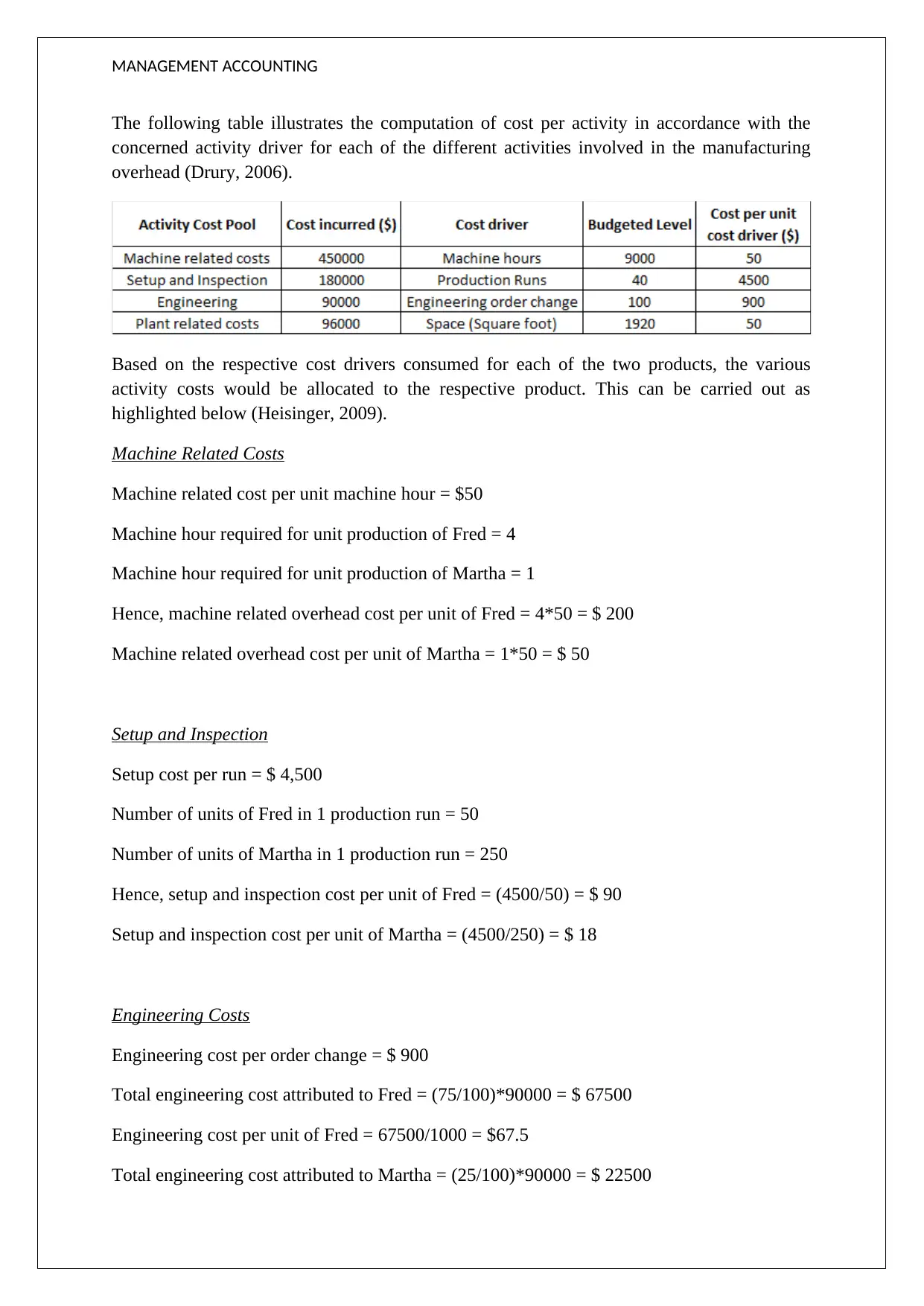
MANAGEMENT ACCOUNTING
The following table illustrates the computation of cost per activity in accordance with the
concerned activity driver for each of the different activities involved in the manufacturing
overhead (Drury, 2006).
Based on the respective cost drivers consumed for each of the two products, the various
activity costs would be allocated to the respective product. This can be carried out as
highlighted below (Heisinger, 2009).
Machine Related Costs
Machine related cost per unit machine hour = $50
Machine hour required for unit production of Fred = 4
Machine hour required for unit production of Martha = 1
Hence, machine related overhead cost per unit of Fred = 4*50 = $ 200
Machine related overhead cost per unit of Martha = 1*50 = $ 50
Setup and Inspection
Setup cost per run = $ 4,500
Number of units of Fred in 1 production run = 50
Number of units of Martha in 1 production run = 250
Hence, setup and inspection cost per unit of Fred = (4500/50) = $ 90
Setup and inspection cost per unit of Martha = (4500/250) = $ 18
Engineering Costs
Engineering cost per order change = $ 900
Total engineering cost attributed to Fred = (75/100)*90000 = $ 67500
Engineering cost per unit of Fred = 67500/1000 = $67.5
Total engineering cost attributed to Martha = (25/100)*90000 = $ 22500
The following table illustrates the computation of cost per activity in accordance with the
concerned activity driver for each of the different activities involved in the manufacturing
overhead (Drury, 2006).
Based on the respective cost drivers consumed for each of the two products, the various
activity costs would be allocated to the respective product. This can be carried out as
highlighted below (Heisinger, 2009).
Machine Related Costs
Machine related cost per unit machine hour = $50
Machine hour required for unit production of Fred = 4
Machine hour required for unit production of Martha = 1
Hence, machine related overhead cost per unit of Fred = 4*50 = $ 200
Machine related overhead cost per unit of Martha = 1*50 = $ 50
Setup and Inspection
Setup cost per run = $ 4,500
Number of units of Fred in 1 production run = 50
Number of units of Martha in 1 production run = 250
Hence, setup and inspection cost per unit of Fred = (4500/50) = $ 90
Setup and inspection cost per unit of Martha = (4500/250) = $ 18
Engineering Costs
Engineering cost per order change = $ 900
Total engineering cost attributed to Fred = (75/100)*90000 = $ 67500
Engineering cost per unit of Fred = 67500/1000 = $67.5
Total engineering cost attributed to Martha = (25/100)*90000 = $ 22500
⊘ This is a preview!⊘
Do you want full access?
Subscribe today to unlock all pages.

Trusted by 1+ million students worldwide
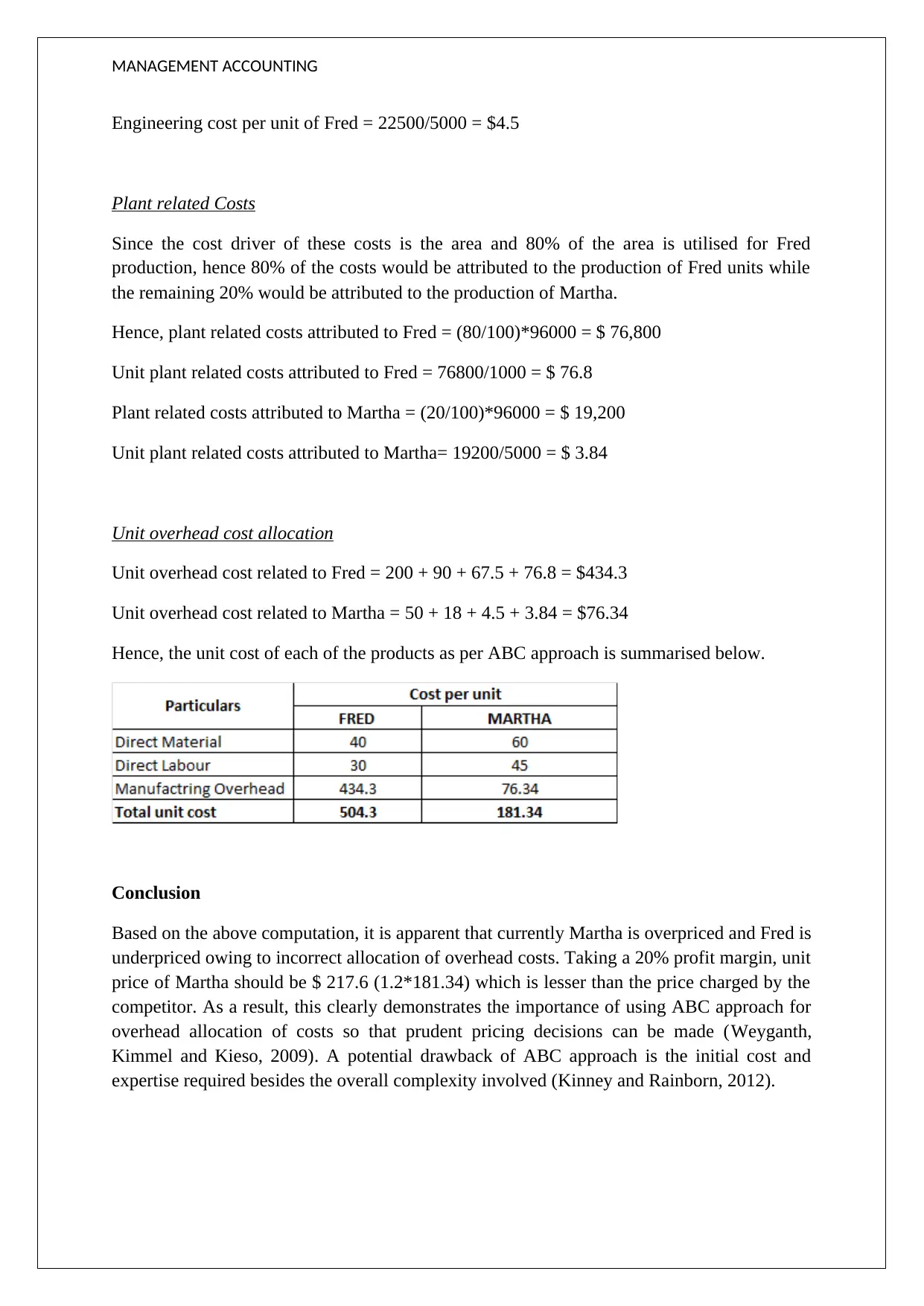
MANAGEMENT ACCOUNTING
Engineering cost per unit of Fred = 22500/5000 = $4.5
Plant related Costs
Since the cost driver of these costs is the area and 80% of the area is utilised for Fred
production, hence 80% of the costs would be attributed to the production of Fred units while
the remaining 20% would be attributed to the production of Martha.
Hence, plant related costs attributed to Fred = (80/100)*96000 = $ 76,800
Unit plant related costs attributed to Fred = 76800/1000 = $ 76.8
Plant related costs attributed to Martha = (20/100)*96000 = $ 19,200
Unit plant related costs attributed to Martha= 19200/5000 = $ 3.84
Unit overhead cost allocation
Unit overhead cost related to Fred = 200 + 90 + 67.5 + 76.8 = $434.3
Unit overhead cost related to Martha = 50 + 18 + 4.5 + 3.84 = $76.34
Hence, the unit cost of each of the products as per ABC approach is summarised below.
Conclusion
Based on the above computation, it is apparent that currently Martha is overpriced and Fred is
underpriced owing to incorrect allocation of overhead costs. Taking a 20% profit margin, unit
price of Martha should be $ 217.6 (1.2*181.34) which is lesser than the price charged by the
competitor. As a result, this clearly demonstrates the importance of using ABC approach for
overhead allocation of costs so that prudent pricing decisions can be made (Weyganth,
Kimmel and Kieso, 2009). A potential drawback of ABC approach is the initial cost and
expertise required besides the overall complexity involved (Kinney and Rainborn, 2012).
Engineering cost per unit of Fred = 22500/5000 = $4.5
Plant related Costs
Since the cost driver of these costs is the area and 80% of the area is utilised for Fred
production, hence 80% of the costs would be attributed to the production of Fred units while
the remaining 20% would be attributed to the production of Martha.
Hence, plant related costs attributed to Fred = (80/100)*96000 = $ 76,800
Unit plant related costs attributed to Fred = 76800/1000 = $ 76.8
Plant related costs attributed to Martha = (20/100)*96000 = $ 19,200
Unit plant related costs attributed to Martha= 19200/5000 = $ 3.84
Unit overhead cost allocation
Unit overhead cost related to Fred = 200 + 90 + 67.5 + 76.8 = $434.3
Unit overhead cost related to Martha = 50 + 18 + 4.5 + 3.84 = $76.34
Hence, the unit cost of each of the products as per ABC approach is summarised below.
Conclusion
Based on the above computation, it is apparent that currently Martha is overpriced and Fred is
underpriced owing to incorrect allocation of overhead costs. Taking a 20% profit margin, unit
price of Martha should be $ 217.6 (1.2*181.34) which is lesser than the price charged by the
competitor. As a result, this clearly demonstrates the importance of using ABC approach for
overhead allocation of costs so that prudent pricing decisions can be made (Weyganth,
Kimmel and Kieso, 2009). A potential drawback of ABC approach is the initial cost and
expertise required besides the overall complexity involved (Kinney and Rainborn, 2012).
Paraphrase This Document
Need a fresh take? Get an instant paraphrase of this document with our AI Paraphraser
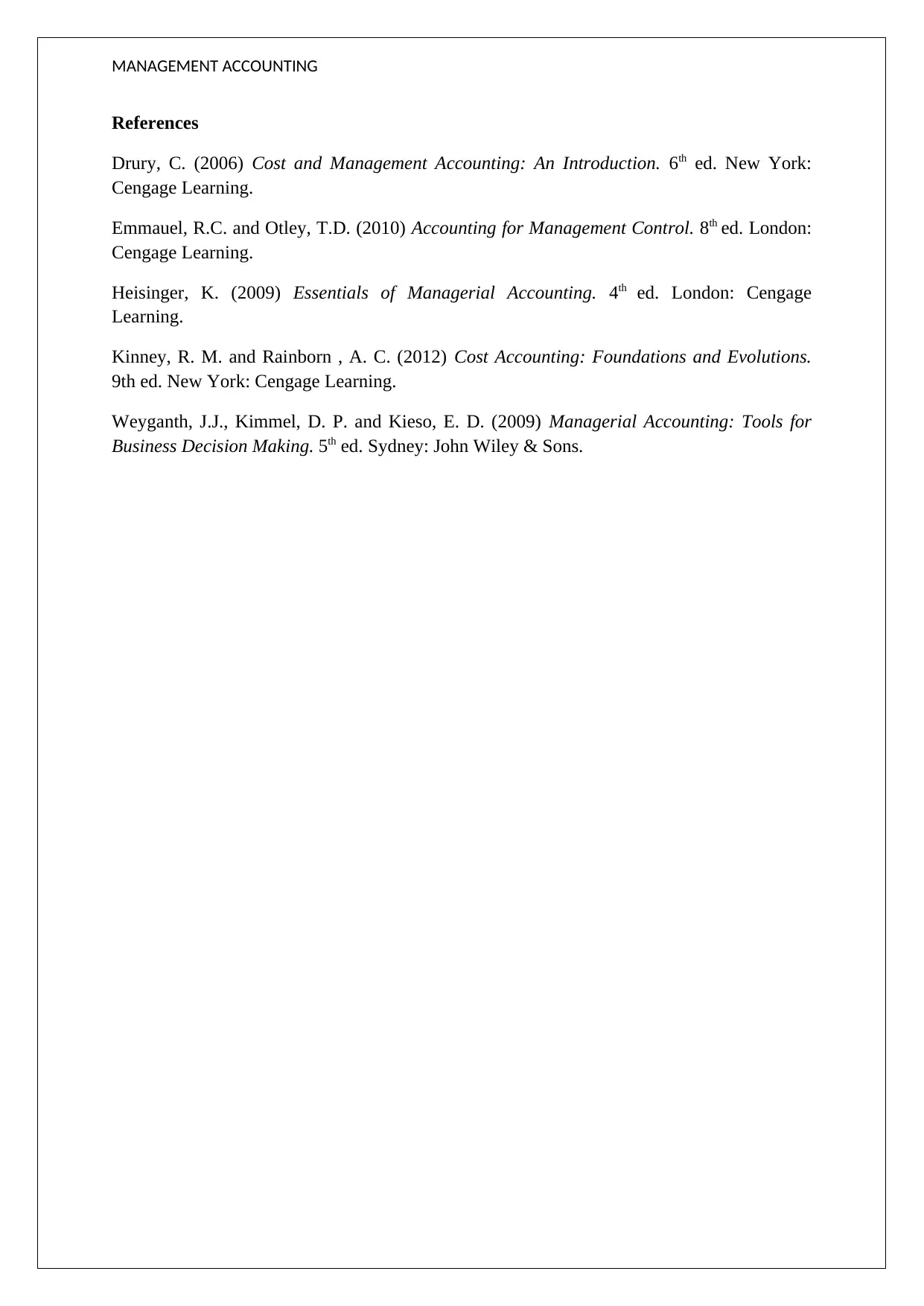
MANAGEMENT ACCOUNTING
References
Drury, C. (2006) Cost and Management Accounting: An Introduction. 6th ed. New York:
Cengage Learning.
Emmauel, R.C. and Otley, T.D. (2010) Accounting for Management Control. 8th ed. London:
Cengage Learning.
Heisinger, K. (2009) Essentials of Managerial Accounting. 4th ed. London: Cengage
Learning.
Kinney, R. M. and Rainborn , A. C. (2012) Cost Accounting: Foundations and Evolutions.
9th ed. New York: Cengage Learning.
Weyganth, J.J., Kimmel, D. P. and Kieso, E. D. (2009) Managerial Accounting: Tools for
Business Decision Making. 5th ed. Sydney: John Wiley & Sons.
References
Drury, C. (2006) Cost and Management Accounting: An Introduction. 6th ed. New York:
Cengage Learning.
Emmauel, R.C. and Otley, T.D. (2010) Accounting for Management Control. 8th ed. London:
Cengage Learning.
Heisinger, K. (2009) Essentials of Managerial Accounting. 4th ed. London: Cengage
Learning.
Kinney, R. M. and Rainborn , A. C. (2012) Cost Accounting: Foundations and Evolutions.
9th ed. New York: Cengage Learning.
Weyganth, J.J., Kimmel, D. P. and Kieso, E. D. (2009) Managerial Accounting: Tools for
Business Decision Making. 5th ed. Sydney: John Wiley & Sons.
1 out of 5
Related Documents
Your All-in-One AI-Powered Toolkit for Academic Success.
+13062052269
info@desklib.com
Available 24*7 on WhatsApp / Email
![[object Object]](/_next/static/media/star-bottom.7253800d.svg)
Unlock your academic potential
Copyright © 2020–2025 A2Z Services. All Rights Reserved. Developed and managed by ZUCOL.





